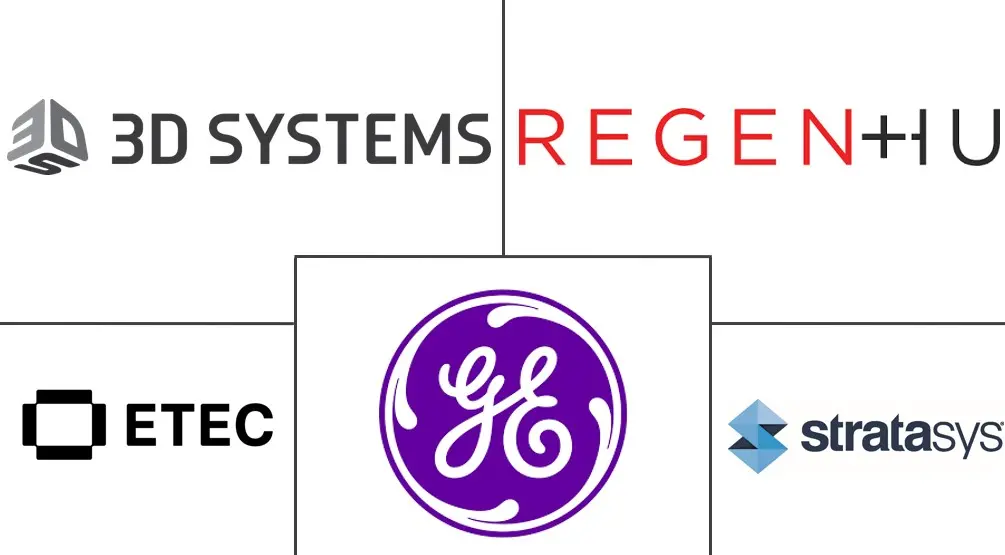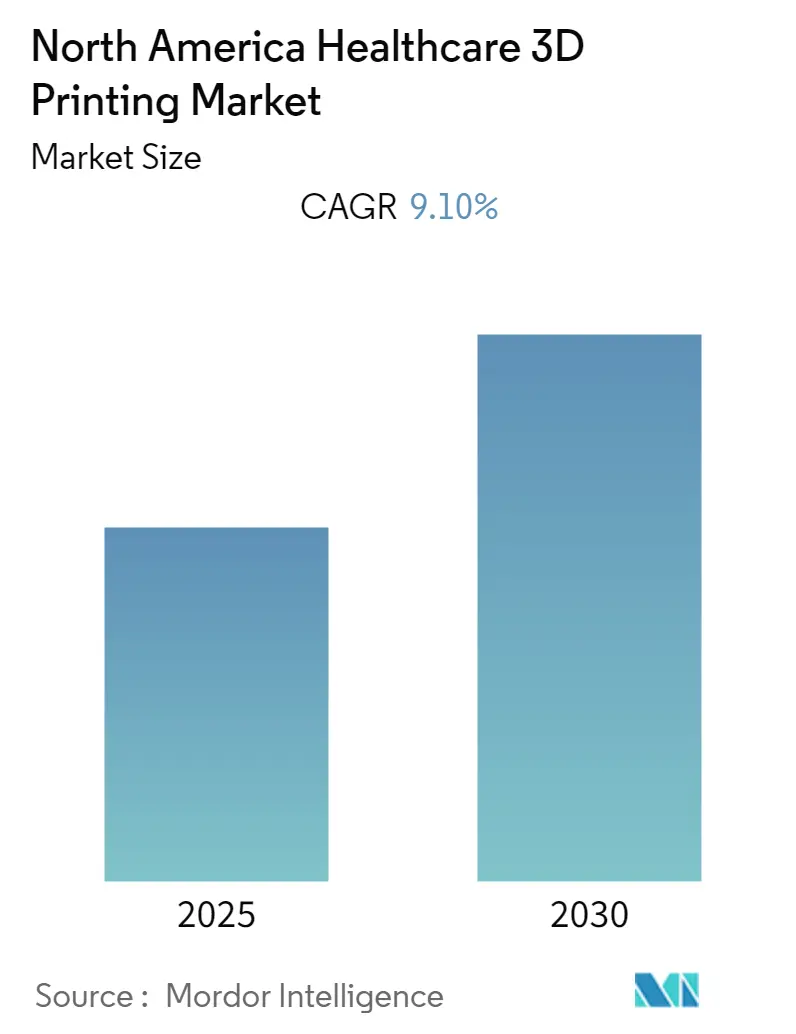
North America Healthcare 3D Printing Market Analysis by Mordor Intelligence
The North America Healthcare 3D Printing Market is expected to register a CAGR of 9.1% during the forecast period.
The factors driving the market's growth are increasing demand for customized additive manufacturing, increasing medical applications, and new patent expiration in the region. 3D printers can create very accurate and comprehensive anatomical models by assisting surgeons in planning for difficult procedures, improving outcomes, and lowering costs. For instance, in 2022, scientists from Florida Atlantic University and the University of Virginia created a robotic model of the human spine to assist surgeons in anticipating the outcomes of interventions before surgery.
Similarly, in February 2022, South Carolina-based DeGen Medical Inc., a spinal implant manufacturer focused on Augmented Reality and Patient-Specific Solutions, commercially launched Impulse AM, a 3D-printed porous titanium implant for posterior interbody fusion. Thus, the increasing demand for 3D printing for healthcare physicians is expected to boost the market over the forecast period.
Patents are important for a government-granted monopoly for a specific method for a limited period. During that period, the patent owner has exclusive rights to use the technology, and other manufacturers may not be able to effectively use the technology's benefits. 3D printing technology has been available for over 30 years, and some patents have expired in recent years. The United States Patent and Trademark Office (USPTO) sets the current patent term at 20 years from the patent application date. The rising benefits of patent expiry, such as cheaper manufacturing and development in the healthcare industry, are anticipated to drive market growth. For instance, according to the study published in the Survey of Ophthalmology in May 2022, over 12,000 patents are related to 3D printing. Many of them are linked to methods, processes, systems, software, and design, and the expiration of patents for some of the 3D printing technologies has resulted in a reduction of expenditure in the healthcare industry in manufacturing and development.
Rising demand for personalized additive manufacturing, expanding medical applications, and expiring patents are anticipated to drive market growth during the forecast period. Several factors may hinder its expansion. Notably, the high cost of additive manufacturing poses affordability challenges, particularly in developing and underdeveloped countries. Additionally, a shortage of skilled professionals to operate these machines presents a significant obstacle. These limitations are likely to curtail market growth in the region.
North America Healthcare 3D Printing Market Trends and Insights
Polymers are Expected to Register High Growth in the Market Over the Forecast Period
Polymer 3D printing is an emerging technology, and various research has increased its use in industry, especially in the medical field. Polymer printing is advantageous because functional parts with different properties and functions can be printed inexpensively. The commercially available polymers for 3D printing in healthcare include acrylonitrile butadiene styrene (ABS), polylactic acid (PLA), polycarbonate (PC), poly ether ester ketone (PEEK), polyetherimide (ULTEM) and thermoplastic elastomers (TPE).
The widespread usage of polymer 3D printing solutions for student education, physician education, and medical device research is expected to have significant growth in the segment over the study period. For instance, in February 2022, Stratasys Ltd, a company in polymer 3D printing solutions, announced that it is sponsoring the University of Minnesota Visible Heart Laboratories with a donation of Stratasys J750 Digital Anatomy 3D printers, MakerBot METHOD X printers, and MakerBot SKETCH 3D printers for education and research. These devices use polymers for 3D printing, and hence, the donation increases the need for polymers, which are likely to propel the segment over the study period.
The new partnerships and acquisitions among the market players are expected to increase the widespread applications of polymers in healthcare 3D printing. For instance,
- In August 2022, Covestro signed an agreement to sell its Additive Manufacturing Business to Stratasys. The business provides material solutions for common polymer 3D printing processes. Covestro's divested business includes employees, research and development facilities, production assets, and offices in the United States.
- In February 2022, 3D Systems agreed to acquire Kumovis, an additive manufacturing solutions provider for personalized healthcare applications. Kumovis' solutions are built upon their extrusion technology, specifically developed for precision printing of medical-grade, high-performance polymers such as PEEK (polyether ether ketone). With this acquisition, 3D Systems added an extrusion technology to its extensive polymer printing healthcare portfolio. This allows the company to expand its addressable market for personalized healthcare applications, which is expected to have a significant impact on the market over the forecast period.
Hence, owing to the above-mentioned factors, such as new sponsoring and company strategies, such as approvals and launches of polymers, the segment is believed to grow significantly during the forecast period.
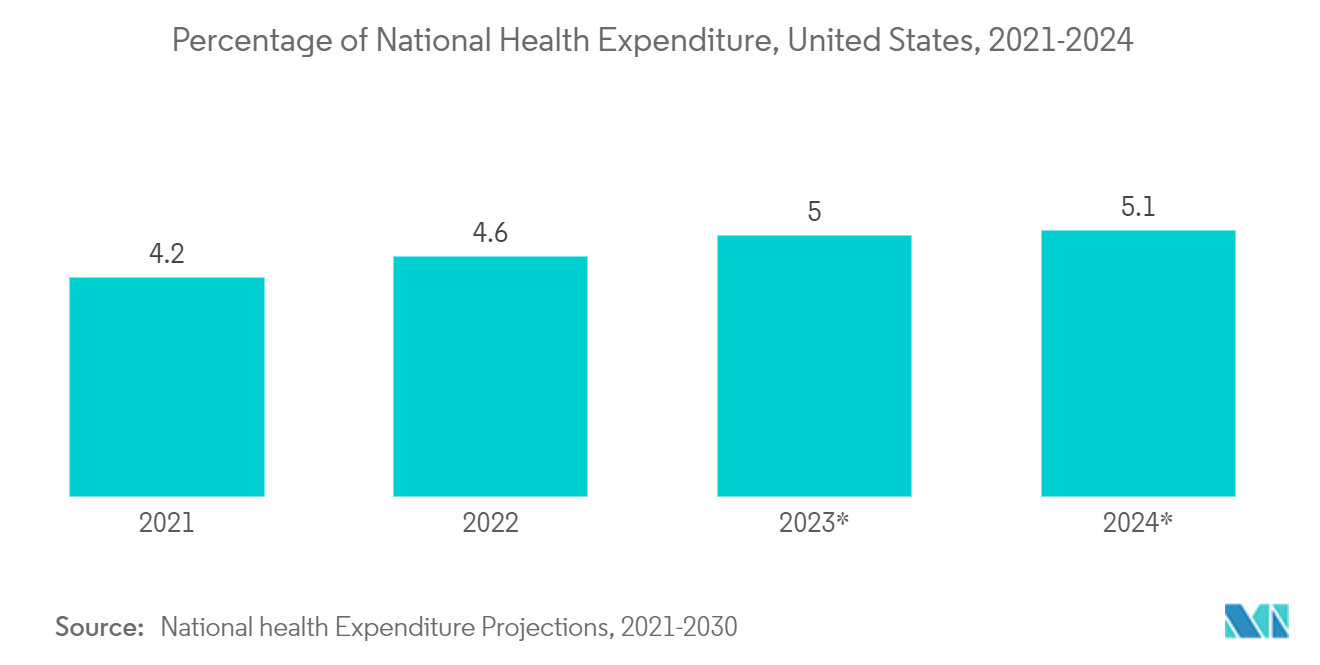
United States is Expected to Have Significant Growth in the Market Over the Forecast Period
Due to their extensive potential for several applications in the healthcare industry, polymers and their composites are among the most frequently utilized materials in additive manufacturing. For many years, polymer-based additive manufacturing has been used to make components for prosthetic limbs and medical equipment.
There has been a significant increase in surgical procedures in recent years in the United States due to the rising prevalence of chronic disease. In addition to using 3D-printed anatomic models to achieve a more accurate perception of the patient's anatomy, these models are also used to perform mock surgeries pre-operatively as per the patient’s anatomy. Thus, an increase in the number of surgeries is likely to create a demand for additive manufacturing in the United States, leading to market growth over the forecast period.
For instance, according to the article update published in January 2023 in the National Library of Medicine, more than 1,000,000 cardiac catheterization procedures are performed annually in the United States1. Cardiovascular applications of additive manufacturing development include adopting patient-specific 3D models for valve surgery, vessel function, and surgical and catheter-based procedural planning. Thus, owing to the increase in catheterization procedures in the United States, the demand for additive manufacturing is likely to rise, fueling market growth over the forecast period.
The new partnerships and acquisitions among the market players are expected to increase the widespread applications of polymers in healthcare 3D printing. For instance,
- In August 2022, Covestro signed a definitive agreement to sell its Additive Manufacturing Business to Stratasys. The business provides material solutions for common polymer 3D printing processes. Covestro's divested business includes employees, research and development facilities, production assets, and offices in the United States.
- In February 2022, 3D Systems agreed to acquire Kumovis, an additive manufacturing solutions provider for personalized healthcare applications. Kumovis' solutions are built upon their extrusion technology, specifically developed for precision printing of medical-grade, high-performance polymers such as PEEK (polyether ether ketone). With this acquisition, 3D Systems added an extrusion technology to its extensive polymer printing healthcare portfolio, allowing it to expand its addressable market for personalized healthcare applications. It is expected to significantly impact the market over the forecast period.
Hence, due to the increase in surgical procedures, the rise in adoption of 3D printed products in healthcare, and the presence of major market players coupled with their strategic activities, such as product launches, the studied market is expected to witness notable growth in the United States.
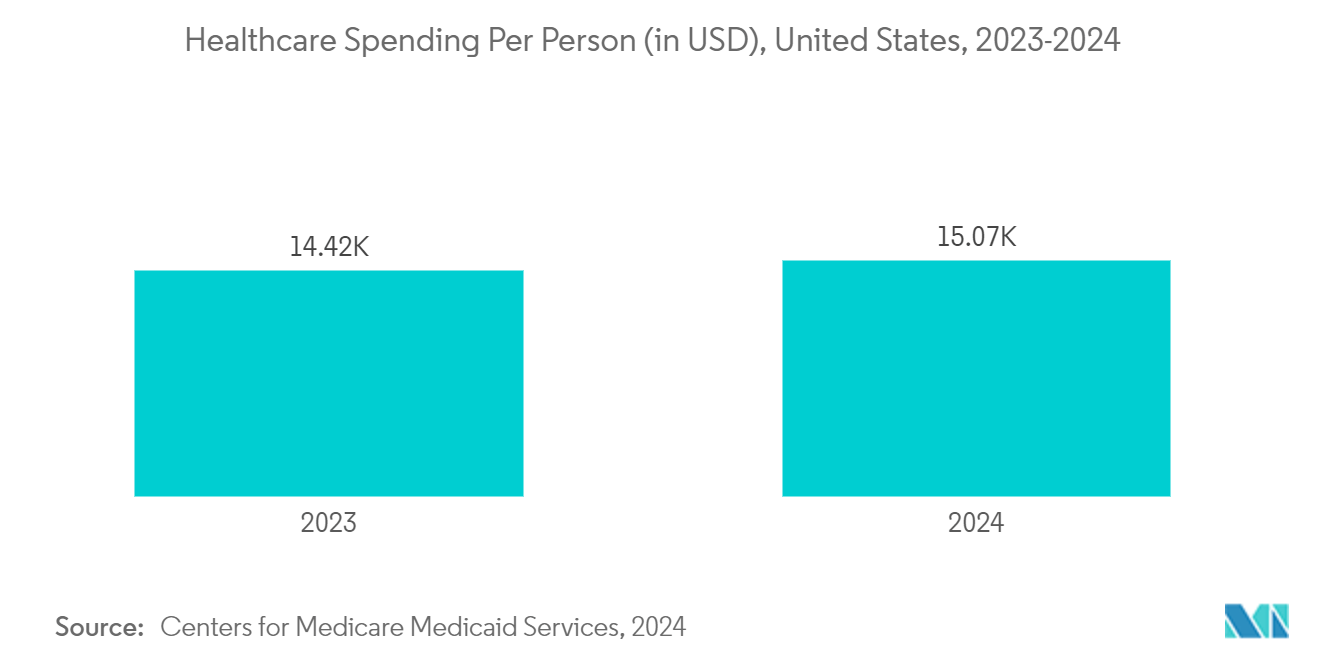
Competitive Landscape
The North American healthcare 3D printing market is fragmented, with several market players. The United States and Canada have developed well-structured healthcare systems. These systems also encourage research and development. These policies encourage market players to enter the United States and Canada. Key players are developing and launching novel products and technologies to compete with existing products, while others are acquiring and partnering with other companies trending in the market. Some of the major market players include 3D Systems Inc., EnvisionTEC, GE Healthcare, Stratasys Ltd, and others.
North America Healthcare 3D Printing Industry Leaders
-
3D Systems, Inc.
-
EnvisionTEC GMBH
-
regenHU
-
Stratasys LTD.
-
GE Healthcare
- *Disclaimer: Major Players sorted in no particular order
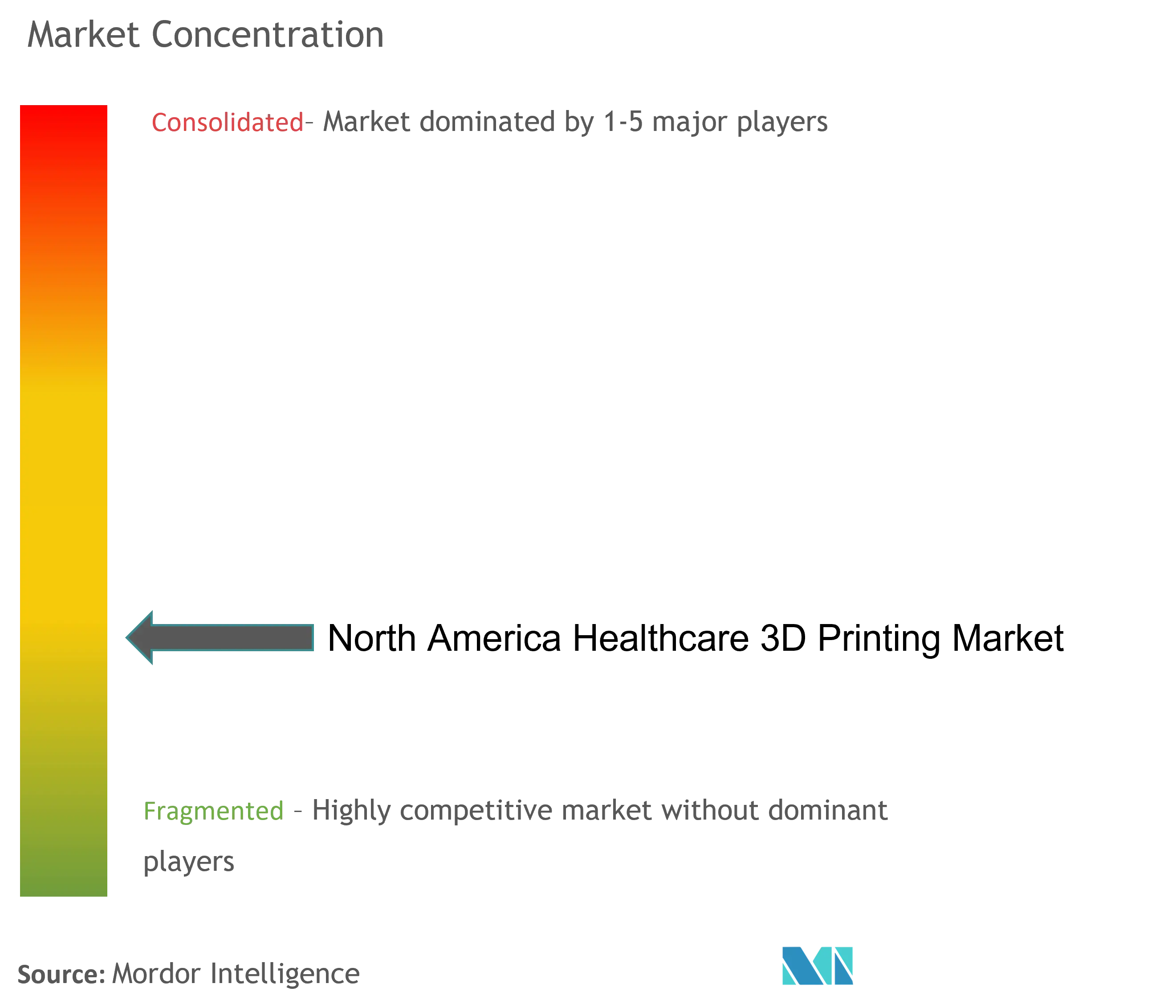
Recent Industry Developments
- January 2023: RMS Company, a United States-based medical device manufacturer, incorporated the DMP Flex 350 Dual into its production process. This new addition belongs to 3D Systems' Direct Metal Printing (DMP) portfolio.
- November 2022: Triastek Inc., a global healthcare company leading the way in 3D printing pharmaceuticals using its proprietary technology, Melt Extrusion Deposition (MED), obtained clearance from the United States FDA for its Investigational New Drug (IND) application. This clearance allows them to commence clinical trials for T21, a 3D-printed medicine with the potential to treat ulcerative colitis.
North America Healthcare 3D Printing Market Report Scope
3D printing, or additive manufacturing, is a transformative approach to industrial production that enables the creation of lighter, stronger parts and systems. In healthcare, this approach is used to create implants, instrument parts, and dummy body parts and organs.
The North American healthcare 3D printing market is segmented by technology, application, materials, and geography. The market is segmented by technology, such as stereolithography, deposition modeling, electron beam melting, laser sintering, jetting technology, laminated object manufacturing, and other technologies. By application, the market is segmented as medical implants, prosthetics, wearable devices, tissue engineering, and other applications. By materials, the market is segmented into metals and alloys, polymers, and other materials. By geography, the market is segmented as (United States, Canada, and Mexico). The report offers the value (in USD) for the above segments.
| Stereolithography |
| Deposition Modeling |
| Electron Beam Melting |
| Laser Sintering |
| Jetting Technology |
| Laminated Object Manufacturing |
| Other Technologies |
| Medical Implants |
| Prosthetics |
| Wearable Devices |
| Tissue Engineering |
| Other Applications |
| Metals and Alloys |
| Polymers |
| Other Materials |
| United States |
| Canada |
| Mexico |
| By Technology | Stereolithography |
| Deposition Modeling | |
| Electron Beam Melting | |
| Laser Sintering | |
| Jetting Technology | |
| Laminated Object Manufacturing | |
| Other Technologies | |
| By Application | Medical Implants |
| Prosthetics | |
| Wearable Devices | |
| Tissue Engineering | |
| Other Applications | |
| By Material | Metals and Alloys |
| Polymers | |
| Other Materials | |
| Geography | United States |
| Canada | |
| Mexico |
Key Questions Answered in the Report
What is the current North America Healthcare 3D Printing Market size?
The North America Healthcare 3D Printing Market is projected to register a CAGR of 9.10% during the forecast period (2025-2030)
Who are the key players in North America Healthcare 3D Printing Market?
3D Systems, Inc., EnvisionTEC GMBH, regenHU, Stratasys LTD. and GE Healthcare are the major companies operating in the North America Healthcare 3D Printing Market.
What years does this North America Healthcare 3D Printing Market cover?
The report covers the North America Healthcare 3D Printing Market historical market size for years: 2019, 2020, 2021, 2022, 2023 and 2024. The report also forecasts the North America Healthcare 3D Printing Market size for years: 2025, 2026, 2027, 2028, 2029 and 2030.
Page last updated on:
North America Healthcare 3D Printing Market Report
Statistics for the 2025 North America Healthcare 3D Printing market share, size and revenue growth rate, created by Mordor Intelligence™ Industry Reports. North America Healthcare 3D Printing analysis includes a market forecast outlook for 2025 to 2030 and historical overview. Get a sample of this industry analysis as a free report PDF download.
